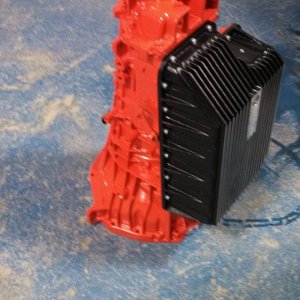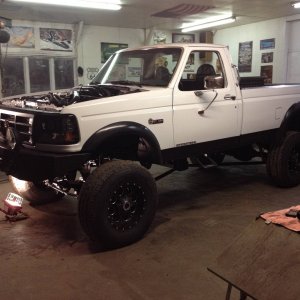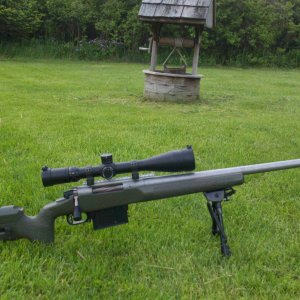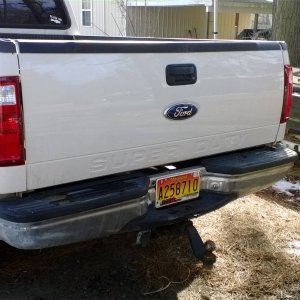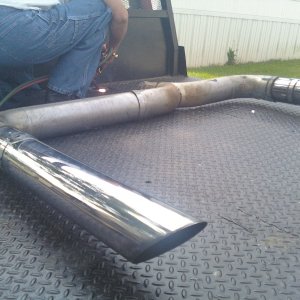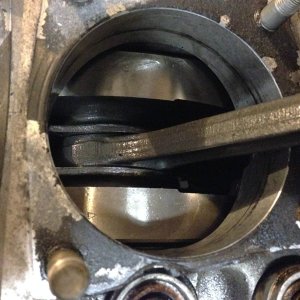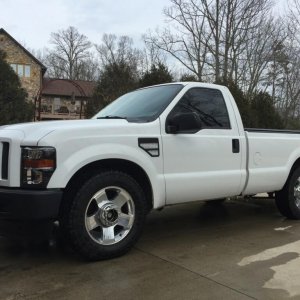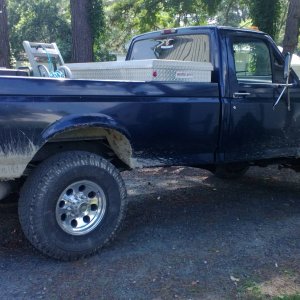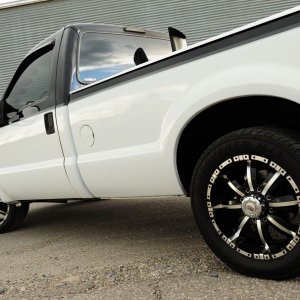Every year, like clock work...
Let's just get this out of the way.
It's that time of year, again, where your diesel is starting to to work a little harder on start up because of dropping temperatures. It does NOT need to be this way! Despite what others have told you about your 6.0, it's not normal for it to white smoke and chug and idle like a cammed big block gasser when you first fire it up. This can be fixed, and in most cases VERY easily.
The two most common (and often overlooked) areas that cause these cold start issues are your batteries, and your FICM (fuel injection control module). Before we can even attempt to diagnose anything else, these two issues need to be addressed and ruled out before moving forward. They are also the easiest to check, and require no specialty tools of any sort.
Batteries! Take them OFF of the truck and bring them to your local parts store and have them LOAD tested. The reason they need to be off of the truck (not attached to each other) is because it's possible one is in great shape, and the other is in a weak condition. The good one can mask the bad one. If you find that one is indeed bad, replace BOTH of them. Yes, BOTH. Replacing only one usually means you'll be replacing them both again shortly anyways. Do it now, save yourself the headache and avoid being caught with a dead truck in a snow storm at the most inconvenient time possible.
Ok, so your batteries checked good, or you put new batteries on. Take a few extra minutes and inspect/clean your connections. All of them. Check the ground cables really well and their connections. It doesn't hurt to just clean them and put your hands on the cables here. Small voltage issues cause big messes with 6.0's.
FICM's! Your batteries are good, next likely culprit is the FICM. The FICM in a nutshell takes your battery voltage of 12-14 and ramps it up to 48V to electronically fire the injector. The FICM has a very important job. If it's weak your truck will let you know. Listen closely when you first turn the key and hear the spool valves being moved. (Buzzing noise under the hood when you first turn the key). If it sounds sporadic and sort of broken up, it's a good sign your batteries suck or your FICM is dying, or both. This is more noticeable in the cold because of the oil becoming thick and causing stiction on your spool valves. There are a few ways to help overcome this issue with FICM programming and such, but I wont get into that here. You need to ensure your FICM is running at proper voltages. There are three conditions that must be checked.
1) 48 Volts @ Key on, engine off
2) 48 Volts @ cranking
3) 48 Volts @ running
You may find you have 48V for two conditions, but not the third, and it can be any one of the three. If it falls below, get it fixed or replaced. There are dozens of places that sell upgrades, and repair services (again, I wont get into that here, this is strictly what you NEED to have a good starting/running truck). Ford says 45 V is the min. I find that if they dip down to the low 40's at first and come back up to 48, it's usually a battery voltage issue. In most cases when the FICM is dying they will have low voltage almost all of the time. If it is weak you will notice the truck will start and run easier as it warms up (oil thinning out).
There are TONS of places to get the test procedure. (youtube) Grab a multi-meter, some basic hand tools (you'll need torx bits as well) and a couple beers and check it. It only takes a few minutes. You can also check it and verify it with software and monitors like the scangauge II etc. Just search around here, tons of info on this.
Ok, so your batteries are good, your FICM is good. For those REALLY cold days, I have a simple procedure I do for start up, especially if the truck hasn't been run in 24 hours and isn't plugged in. I typically turn the key forward and listen to the spool valves buzzing. I basically ignore my wait to start light in the winter. Listen to how quickly the spool valves buzz. You'll hear them get quicker as the oil is moved off of the spool valve. I usually let the injectors buzz once until they shut off, then turn the key off, and back forward again and let them run another complete buzz. Usually two is good and I start the truck. If you listen to your injectors, you'll know when it's a good time to start. If everything is in good shape voltage wise, and you let them buzz until they sound healthy... you should have NO starting issues. I can fire my truck in 0* F weather without being plugged in and it will fire good and strong with virtually no smoke.
Obviously these are not the end-all fixes but they are the two most common. A few other things to try to help in cold start situations...
Plugging in always helps. It's not always needed, or even available, but it is just much easier on everything.
A good quality synthetic 5w-40 oil. IMO, you should be running this anyway in a 6.0 (motorcraft filters only....)
An oil additive. Hot subject here, but they have been known to work well. The common one's are Hot Shot Secrets, Rev-X, and Archoil 9100. I prefer the Archoil myself because of cost and effectiveness, your results may vary.
If after all of this, you still have issues, post it up here and we can help you diagnose. It could be an issue with injection pressures, or even simply a bad injector or two. Again, start with the basics. The glow plug system may also be another area that needs attention, but they seem to be quite robust on the 6.0's. You can find the test specs for glow plugs and the glow plug control module posted on this board. Do an advanced search for my name and glow plug test and it should come up.
I know this seems pretty basic, and if you live in TX you may not even care, but this literally could be a potentially life or death situation. You do NOT want to be caught out in the wilderness in freezing temps with a temperamental 6.0 that wont start. That is NOT the time you want to realize your FICM isn't up to the job of moving 8 spool valves. Check it now, get it out of the way.
Any questions just ask.
:thumbup:
Let's just get this out of the way.
It's that time of year, again, where your diesel is starting to to work a little harder on start up because of dropping temperatures. It does NOT need to be this way! Despite what others have told you about your 6.0, it's not normal for it to white smoke and chug and idle like a cammed big block gasser when you first fire it up. This can be fixed, and in most cases VERY easily.
The two most common (and often overlooked) areas that cause these cold start issues are your batteries, and your FICM (fuel injection control module). Before we can even attempt to diagnose anything else, these two issues need to be addressed and ruled out before moving forward. They are also the easiest to check, and require no specialty tools of any sort.
Batteries! Take them OFF of the truck and bring them to your local parts store and have them LOAD tested. The reason they need to be off of the truck (not attached to each other) is because it's possible one is in great shape, and the other is in a weak condition. The good one can mask the bad one. If you find that one is indeed bad, replace BOTH of them. Yes, BOTH. Replacing only one usually means you'll be replacing them both again shortly anyways. Do it now, save yourself the headache and avoid being caught with a dead truck in a snow storm at the most inconvenient time possible.
Ok, so your batteries checked good, or you put new batteries on. Take a few extra minutes and inspect/clean your connections. All of them. Check the ground cables really well and their connections. It doesn't hurt to just clean them and put your hands on the cables here. Small voltage issues cause big messes with 6.0's.
FICM's! Your batteries are good, next likely culprit is the FICM. The FICM in a nutshell takes your battery voltage of 12-14 and ramps it up to 48V to electronically fire the injector. The FICM has a very important job. If it's weak your truck will let you know. Listen closely when you first turn the key and hear the spool valves being moved. (Buzzing noise under the hood when you first turn the key). If it sounds sporadic and sort of broken up, it's a good sign your batteries suck or your FICM is dying, or both. This is more noticeable in the cold because of the oil becoming thick and causing stiction on your spool valves. There are a few ways to help overcome this issue with FICM programming and such, but I wont get into that here. You need to ensure your FICM is running at proper voltages. There are three conditions that must be checked.
1) 48 Volts @ Key on, engine off
2) 48 Volts @ cranking
3) 48 Volts @ running
You may find you have 48V for two conditions, but not the third, and it can be any one of the three. If it falls below, get it fixed or replaced. There are dozens of places that sell upgrades, and repair services (again, I wont get into that here, this is strictly what you NEED to have a good starting/running truck). Ford says 45 V is the min. I find that if they dip down to the low 40's at first and come back up to 48, it's usually a battery voltage issue. In most cases when the FICM is dying they will have low voltage almost all of the time. If it is weak you will notice the truck will start and run easier as it warms up (oil thinning out).
There are TONS of places to get the test procedure. (youtube) Grab a multi-meter, some basic hand tools (you'll need torx bits as well) and a couple beers and check it. It only takes a few minutes. You can also check it and verify it with software and monitors like the scangauge II etc. Just search around here, tons of info on this.
Ok, so your batteries are good, your FICM is good. For those REALLY cold days, I have a simple procedure I do for start up, especially if the truck hasn't been run in 24 hours and isn't plugged in. I typically turn the key forward and listen to the spool valves buzzing. I basically ignore my wait to start light in the winter. Listen to how quickly the spool valves buzz. You'll hear them get quicker as the oil is moved off of the spool valve. I usually let the injectors buzz once until they shut off, then turn the key off, and back forward again and let them run another complete buzz. Usually two is good and I start the truck. If you listen to your injectors, you'll know when it's a good time to start. If everything is in good shape voltage wise, and you let them buzz until they sound healthy... you should have NO starting issues. I can fire my truck in 0* F weather without being plugged in and it will fire good and strong with virtually no smoke.
Obviously these are not the end-all fixes but they are the two most common. A few other things to try to help in cold start situations...
Plugging in always helps. It's not always needed, or even available, but it is just much easier on everything.
A good quality synthetic 5w-40 oil. IMO, you should be running this anyway in a 6.0 (motorcraft filters only....)
An oil additive. Hot subject here, but they have been known to work well. The common one's are Hot Shot Secrets, Rev-X, and Archoil 9100. I prefer the Archoil myself because of cost and effectiveness, your results may vary.
If after all of this, you still have issues, post it up here and we can help you diagnose. It could be an issue with injection pressures, or even simply a bad injector or two. Again, start with the basics. The glow plug system may also be another area that needs attention, but they seem to be quite robust on the 6.0's. You can find the test specs for glow plugs and the glow plug control module posted on this board. Do an advanced search for my name and glow plug test and it should come up.
I know this seems pretty basic, and if you live in TX you may not even care, but this literally could be a potentially life or death situation. You do NOT want to be caught out in the wilderness in freezing temps with a temperamental 6.0 that wont start. That is NOT the time you want to realize your FICM isn't up to the job of moving 8 spool valves. Check it now, get it out of the way.
Any questions just ask.
:thumbup:
Last edited:

